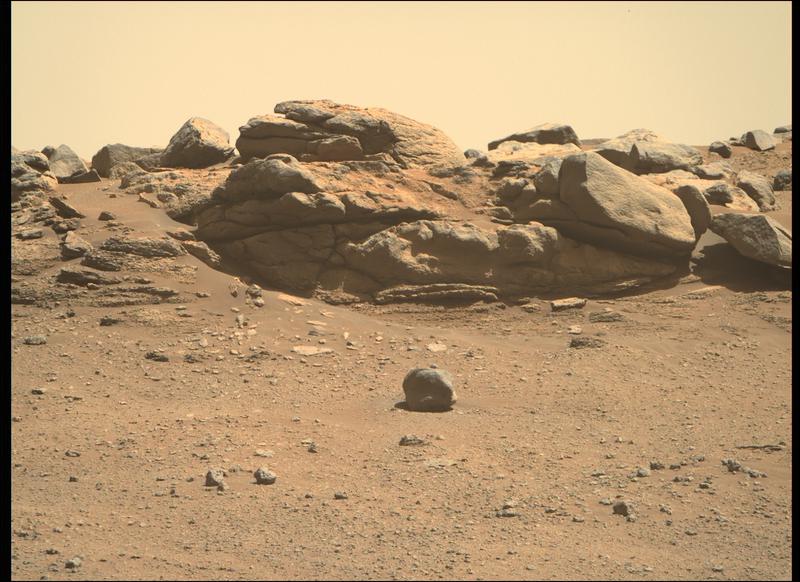It looks like you're using an Ad Blocker.
Please white-list or disable AboveTopSecret.com in your ad-blocking tool.
Thank you.
Some features of ATS will be disabled while you continue to use an ad-blocker.
share:
originally posted by: Alien Abduct
a reply to: Box of Rain
The rippled dunes on Mars are evidence of the wind-driven dust and sand that has been eroded from rocks.
Of course the very thin (0.4% earth's) atmosphere causes a very slow and mild erosion. However the rocks in question in the OP are rocks at the bottom of a dry lake bed. They look much much more warn than the surrounding rocks. This is because they were once being eroded by liquid water which erodes rocks thousands of times faster than Mars' atmosphere.
There was apparently water there at some time, and it did its erosion job. But that was likely a billion years ago or more. Since then, it's been wind-blown dust, which doesn't seem like a lot but give it a couple billion years and everything on the surface should be nice and smooth. But it isn't. Sharp-edged boulders everywhere. How did those get there?
edit on 14-5-2021 by Blue Shift because: (no reason given)
originally posted by: Blue Shift
originally posted by: Alien Abduct
a reply to: Box of Rain
The rippled dunes on Mars are evidence of the wind-driven dust and sand that has been eroded from rocks.
Of course the very thin (0.4% earth's) atmosphere causes a very slow and mild erosion. However the rocks in question in the OP are rocks at the bottom of a dry lake bed. They look much much more warn than the surrounding rocks. This is because they were once being eroded by liquid water which erodes rocks thousands of times faster than Mars' atmosphere.
There was apparently water there at some time, and it did its erosion job. But that was likely a billion years ago or more. Since then, it's been wind-blown dust, which doesn't seem like a lot but give it a couple billion years and everything on the surface should be nice and smooth. But it isn't. Sharp-edged boulders everywhere. How did those get there?
Dude......I'm not denying that the wind and dust does a little erosion. The subject in the OP and the picture I was referring to was the rocks in the dry lake bed....perhaps you should reread my previous posts.
a reply to: Alien Abduct
I'm wondering if NASA find the formation Intriguing because the circular shape hints at hydrothermal activity.

Just a thought.
I'm wondering if NASA find the formation Intriguing because the circular shape hints at hydrothermal activity.

Just a thought.
a reply to: gortex
That's a vary interesting thought. If that's the case then that would certainly make it a better spot to look. Because even long after the atmosphere had gone making the planet cold, that spot would remain warm for life to continue....until the lake evaporated of course.
That's a vary interesting thought. If that's the case then that would certainly make it a better spot to look. Because even long after the atmosphere had gone making the planet cold, that spot would remain warm for life to continue....until the lake evaporated of course.
a reply to: gortex
I wonder how many people are still following the Perseverance rover?
I check the images every day, because every day it takes more photos and every day, there are cool new images...
Like this one...
Mars Perseverance Sol 162: Right Mastcam-Z Camera

What is that in the lower right ? A rock? A snake like creature?
Hmmm....
(right click and open the image in a new tab to see it larger so you can see what I am talking about)
Amazing photos every day!
I love it!
The link to photos posted...every day...
mars.nasa.gov...
I wonder how many people are still following the Perseverance rover?
I check the images every day, because every day it takes more photos and every day, there are cool new images...
Like this one...
Mars Perseverance Sol 162: Right Mastcam-Z Camera

What is that in the lower right ? A rock? A snake like creature?
Hmmm....
(right click and open the image in a new tab to see it larger so you can see what I am talking about)
Amazing photos every day!
I love it!
The link to photos posted...every day...
mars.nasa.gov...
edit on 3-9-2021 by Darkblade71 because: Link added
new topics
-
D.B. Cooper mystery may be solved
General Conspiracies: 1 hours ago
top topics
-
D.B. Cooper mystery may be solved
General Conspiracies: 1 hours ago, 6 flags
